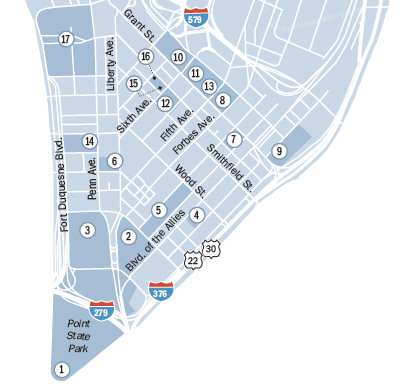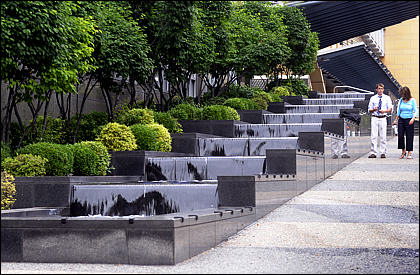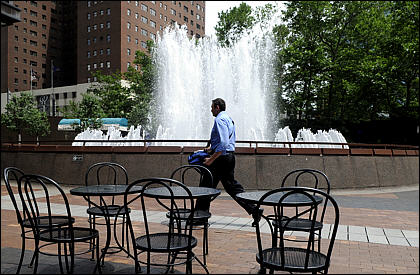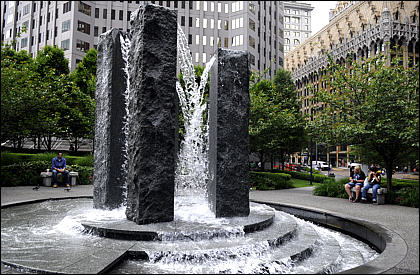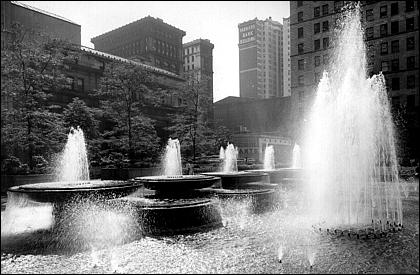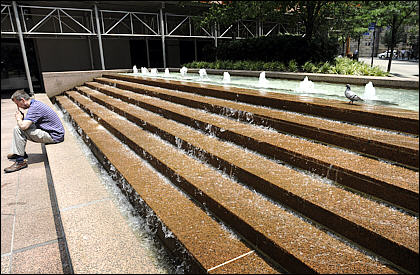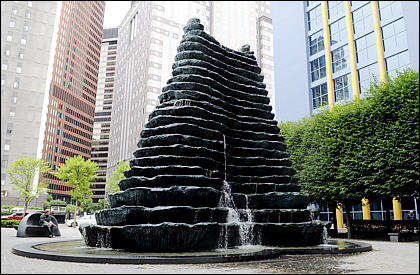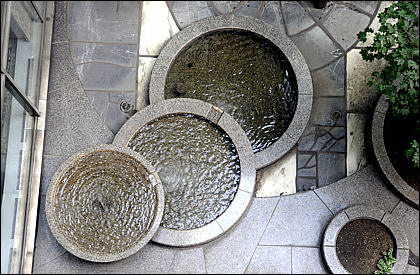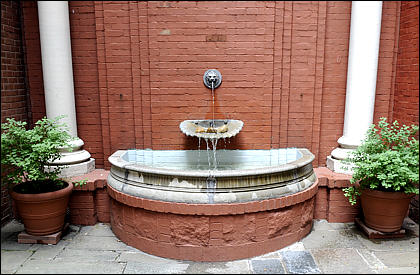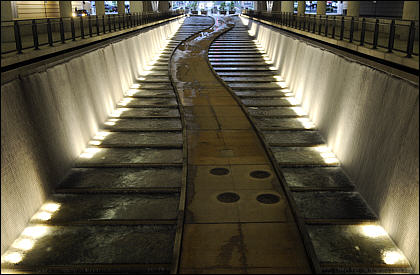
Category Archive: City Living
-
Rodef Shalom’s Garden Grows into Latest Exhibit of Wearable Greens
By Alaina Raftis , TRIBUNE-REVIEW
Thursday, July 15, 2010
The heavily cultivated and well-maintained garden -- which sits on a third of an acre off of Fifth Avenue in Oakland -- was created by Irene Jacob, a botanist who founded the docent program at Phipps Conservatory and Botanical Gardens, and her husband, Rabbi Walter Jacob, to bring people closer to the Bible in a nontraditional way. Justin Merriman | Tribune-Review
The lush greenery at Rodef Shalom’s Biblical Botanical Garden is celebrating it’s 25th year with a new exhibit titled “What Shall I Wear?”
This year, the garden showcases various plants and flowers that have been used to make clothing and fragrances for thousands of years.
The heavily cultivated and well-maintained garden — which sits on a third of an acre off of Fifth Avenue in Oakland — was created by Irene Jacob, a botanist who founded the docent program at Phipps Conservatory and Botanical Gardens, and her husband, Rabbi Walter Jacob, to bring people closer to the Bible in a nontraditional way.
Often referred to as “Little Israel” because its geography replicates the confines of the Holy Land, the garden features various miniature landmarks such as Mt. Hermon, a mound of stones stacked beneath the shade of the billowing Acacia trees, and the Jordan River, a tranquil stream of water trickling from one corner of the garden to another.
The thousands of signatures penned in the guest book each season are only one sign of the garden’s success.
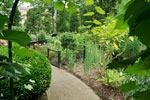
Often referred to as "Little Israel" because its geography replicates the confines of the Holy Land, the garden features various miniature landmarks such as Mt. Hermon, a mound of stones stacked beneath the shade of the billowing Acacia trees, and the Jordan River, a tranquil stream of water trickling from one corner of the garden to another. Justin Merriman | Tribune-Review
“This is the largest and most complete garden of its kind,” says Arlyn Gilboa, who has been a docent at the garden for 15 years, “It’s wholly dedicated.”
The garden contains 56 out of 110 plants specifically mentioned in the Bible and an additional 50 flowers that Jacob added to awaken the verdant oasis.
“Some people come to Pittsburgh just to see the garden,” says Jean Simon, another docent.
Plants that aren’t mentioned in the Bible were given creative names such as, “Jacob’s Coat,” “Angel’s Tears” and “Elijah’s Blue” to play along with the biblical theme.
This year’s exhibit “was just something new that we haven’t focused on before,” Gilboa says. “Sometimes our exhibits don’t have biblical roots, but this year it certainly does.”
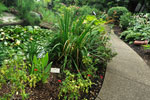
The garden contains 56 out of 110 plants specifically mentioned in the Bible plus more. Justin Merriman | Tribune-Review
Some of the plants featured in this year’s exhibit are used for the essential oils in perfumes and fragrances. They include, among others, banana shrubs, carnations, chamomile, gardenia, geranium, jasmine, kumquat, lemon verbena, mock orange, musk plant, myrtle, patchouli, rose, rosemary and sage. The cotton and flax plants also are displayed and both have been used to make clothing since the ancient times.
“It’s a wonderful thing,” Gilboa looks at the two massive Cedar of Lebanon trees at the entrance to the garden. “The fact is that the ancients were dependent on plants, and so are we. For me, I feel a strong connection with Jewish history when I’m here. It’s such a treat.”
Rodef Shalom Biblical Botanical GardenWhen: Through Sept. 15. Hours: 10 a.m.-2 p.m. Sundays-Thursdays; 7-9 p.m. Wednesdays; noon-1 p.m. Saturdays Guided tours available 12:15-1 p.m. Aug. 6 and Sept. 3
Admission: Free
Where: Rodef Shalom Temple, 4905 Fifth Ave., Oakland
Details: 412-621-6566
-
North Side Theater is “Spruced Up” — for Hollywood
By Bill Vidonic
PITTSBURGH TRIBUNE-REVIEW
Friday, July 16, 2010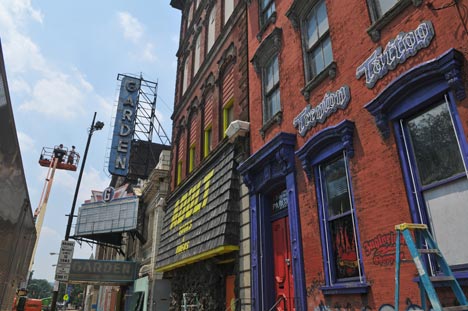
Workers are transforming the old Garden Theater and surrounding buildings in the North Side into a seedy city block of Trenton, N.J., in preparation for filming next week of the movie "One for the Money," starring Katherine Heigl. JC Schisler | Tribune-Review
More than one person passing the former Garden Theater in the North Side did a double-take Thursday, likely wondering whether a decade of working to rid the block of porn establishments suddenly reversed.
Workers replaced the neon on the old X-rated theater’s dilapidated sign. Next door, a painter finished the words “Adult Books and Videos” on the old Apache Bar facade, while others put finishing touches on the Trenton Tattoo parlor, complete with neon lights and spray-painted graffiti.
“(Former) Mayor Murphy took a nap, and here’s what happened,” painter Darien D’Alfonso joked.
Turns out it’s just movie magic.
A production crew for the film “One For the Money” starring Katherine Heigl is transforming the blighted city block into a seedy Trenton, N.J., street; filming starts Wednesday.
That means bringing the exterior of the Garden back to life and creating fake businesses, including a hoagie shop, from vacant storefronts.
“From our perspective, it’s quite ironic, but at the same time it’s exciting,” said Joanna Doven, spokeswoman for Pittsburgh Mayor Luke Ravenstahl. “There are good positive things happening in that area.”
The city spent millions in a lengthy legal battle to clear dilapidated buildings from the section of North Avenue near Allegheny General Hospital before it bought the Garden for $1.1 million in 2007.
“I think it’s great if it’s bringing the city some money,” neighbor Laurie Charlton said about the movie production. “Everybody in the neighborhood is excited about this block coming back to life.”
The Northside Leadership Conference is accepting redevelopment proposals for the Garden and surrounding buildings. A meeting about the redevelopment is scheduled for 6 p.m. Monday in the Children’s Museum.
“It’s a new day there soon,” Doven said.
For a little while longer, though, it will look like the old days.
“I think it’s kinda stupid,” North Side resident William McCue said. “They could have just been here three or four years ago, and everything would have been open for them.”
-
Group Asks 1-Year Delay in Mellon Arena Demolition
Thursday, July 15, 2010By Mark Belko, Pittsburgh Post-GazetteA group seeking to save Mellon Arena today urged its owner to delay a proposed demolition for one year.
Rob Pfaffmann, a Downtown architect who leads Reuse the Igloo, asked the city-Allegheny County Sports & Exhibition Authority board to give the group a year to develop an economically viable plan to save the Igloo. The SEA owns the building.
“We do not want to see a white elephant,” he said.
Mr. Pfaffmann said the group also would develop a plan to help the SEA cover the operating costs of the building while a more thorough planning process is undertaken and alternatives are studied.
“We should not rush to judgment on this if we have an economic circumstance that doesn’t demand it,” he said.
Mr. Pfaffmann was among about 10 people to speak at the SEA meeting today in favor of saving the building.
“There’s no do over. Once it’s gone, it’s gone and it will never be back again,” said Nancy Motz Cosnotti. “If the Civic Arena is gone, then part of Pittsburgh will be gone and I don’t want that.”
Reuse the Igloo also would like to see the SEA open the arena’s distinctive dome as a demonstration to see if it still works and to determine the cost of operating it.
SEA Executive Director Mary Conturo said no vote has been scheduled yet on a demolition, favored by the Penguins, Mayor Luke Ravenstahl and county Executive Dan Onorato.
She said the SEA is still in the process of reviewing options through an ongoing historic review process.
Asked whether the SEA would agree to a one-year delay, board chairman Wayne Fontana said the request would be taken under advisement.
“I’m not adverse to anything at this point,” he said.
-
Pools, Rivers, Fountains and More Offer Splashing Fun
By Pittsburgh Tribune-Review
Wednesday, July 14, 2010When it comes to cooling off, there aren’t many better or more efficient ways than getting soaked.
There are a variety of pools, rivers, fountains, rides and more available in Western Pennsylvania to take the edge off of even the hottest days — and we’ve certainly had plenty of those lately. So get out there and get wet.
Wave poolsThere’s nothing like getting drenched at one of Allegheny County’s three wave pools. On a sweltering day, few things are more inviting than a heaving expanse of cool blue water, with the afternoon sun dancing on the frothy waves. The county operates wave pools at Settler’s Cabin Park in Robinson, South Park in Bethel Park and Boyce Park in Plum.
The waves are created by a series of chambers concealed behind the rear wall of the pool. They blow compressed air that produces the waves, says Joe Olczak, director of public works. He says they can alter the height of the wave by changing the firing sequence of the chambers. They could make a wave as large as five feet, he says.
“We normally don’t do that because there’s a lot of young kids. We try to keep the waves one to two feet high.”
Settler’s Cabin wave pool is the most heavily used of the three. To beat the rush, go during the week. The weekend rush starts not long after the 11:30 a.m. opening time Friday. No outside food or drinks are permitted, but customers are permitted to bring their own chairs. Inner tubes can be rented for $5, with $1 refunded on the return.
All three pools are open 11:30 a.m. to 7 p.m. daily. Admission is $5 for adults; $4 for ages 13-17; $3 for age 60 and older and ages 6-12; $1 for age 5 and younger. Group discounts are available. Details: Settler’s Cabin Wave Pool, 412-787-2667; South Park Wave Pool, 412-831-0810; Boyce Park Wave Pool, 724-325-4677, or www.alleghenycounty.us/parks/fees/pools.aspx.
— William Loeffler
The big poolsPeople fond of whopping places for a cool plunge can choose from some of the biggest pools in Western Pennsylvania. Admission rates for adults range from $5 to $7.
North Park Pool — a 57,000-square-foot landmark built in the early 1930s — once claimed to be the largest pool in the United States. It offers a 20-foot-tall curved slide, separate baby pool, concession stand, swimming classes and 25-cent lockers in a big, slate-roofed bathhouse. Swimmers can rent flotation tubes, but rafts, belly boards and other flotation devices are prohibited. North Park Pool is on South Ridge Road in McCandless. Hours: 11:30 a.m. to 7:30 p.m. daily. Details: 724-935-1951.
Dormont Pool is longer than a football field and also offers a curved slide, concession stand and swimming lessons, plus water aerobics classes. Dormont Pool is at Banksville Road and Dormont Avenue. Hours: noon to 8 p.m. daily. Details: 412-341-7210.
Ligonier Beach — a 400-by-100-foot pool — opened July 4, 1925, and shares 10 acres with a sit-down restaurant, picnic grove, sand area, snack bar, poolside bar and game room. Entertainer Dean Martin once worked as “a towel boy” at the pool, and bands continue to perform 2 to 6 p.m. Sundays. Feel free to bring your own raft or other flotation device. Ligonier Beach is at 1752 Route 30 East in Ligonier Township, Westmoreland County. Hours: 11 a.m. to 7 p.m. daily. Details: 724-238-5553 or www.ligonierbeach.com.
— Deborah Deasy
State parksPerhaps you’re allergic to chlorine. Maybe you don’t like man-made waves. Or it could be you’d rather not pay to swim.
Three state parks in the region offer cost-effective alternatives to crowded, and sometimes pricey, municipal and public pools.
At Keystone State Park in Derry, Westmoreland County, a 1,000-foot sand beach lies on the northern rim of Keystone Lake. No food, pets, beverages are allowed on the sand. Swimming is available from 8 a.m. to dusk, from mid-May through mid-September.
Moraine State Park in Portersville, Butler County, offers two swimming areas. Pleasant Valley Beach on the south shore of Lake Arthur features a 1,200-foot sand-and-turf beach, with a playground and sand volleyball court nearby. A 550-foot sand beach is the main feature of Lakeview Beach on the north shore. Both beaches have showers, changing rooms and food concessions nearby, and are open from sunrise to sunset, from Memorial Day weekend through Labor Day weekend. No pets are permitted on the beaches.
Raccoon State Park in Hookstown, Beaver County, features an 800-foot, sand-and-turf beach, with a bathhouse and concession stand nearby. Swimming is available from mid-May through mid-September.
All state parks are swim at your own risk; swimming at all state parks is free. Details: www.dcnr.state.pa.us/stateparks/index.aspx.
— Rege Behe
OhiopyleGetting wet is easy around Ohiopyle. But watch out, it can be dangerous, too.
The Fayette County town is in the middle of a great outdoor area featuring mountains, a long bike trail and, of course, the Youghiogheny River. That waterway offers rafting trips that are among the best-known in the Mid-Atlantic area. Even if you stay in the boat, you’re bound to get wet.
The trips that begin near the town explore 7 1/2 miles of the Lower Yough, blasting through Class III and IV rapids. This is not a trip to be taken lightly and safety talks are part of every adventure to make sure rafters know what to do if they are tossed from the boat.
If these rapids are not enough, try trips on the Upper Yough, which is above the reservoir gated at nearby Confluence. This 5-mile trip roars through class V rapids and drops an average on 115 feet per mile. Because this is not dam-controlled these trips usually are spring-oriented when runoff gives the river flow.
But don’t forget the Middle Yough from Confluence to Ohiopyle. This stretch provides a generally placid trip with a few Class I and II rapids. Basically, though, it is a lovely trip through a deep Appalachian valley, the stuff folk songs are made of.
Outfitters such as Wilderness Voyageurs (800-272-4141) or Ohiopyle Trading Post (888-644-6795) handle a variety of trips near Ohiopyle. Prices vary according to the day, the trip, what kind of lunch is offered, or whether a guide is needed or included. They can go as high as $150 on the Upper Yough, $95 for the Lower or around $35 for a float on the Middle.
— Bob Karlovits
Spray parksCommunity swimming pools aren’t cheap to run and maintain, and every year, it seems, there’s a battle to keep more from closing. Another way for kids to cool off during the dog days of summer is the spray park.
Pittsburgh has two — one in Troy Hill that opened last year, and a new one that opened in Beechview this summer.
Spray parks feature an array of different water features, fountains, sprinklers, sprayers and mist-makers, many with sensors triggered by movement. Kids can sprint through the spray park setting them all off, or spend time soaking and redirecting the flow of their favorite features.
There’s no age limit, no worries about falling into the deep end. Children with disabilities — even wheelchairs — can participate.
“The response has been really great,” says Mike Radley, director of Citiparks. “It reaches a large spectrum of kids and neighbors.”
There are two other Allegheny County-run spray parks outside the city, at Round Hill Park in Elizabeth and Deer Lakes Park in Frazier. The one at Round Hill Park is called the Aquatic Playground, and has a farm theme — with fountains and sprayers shaped like pigs, barn doors and tall sunflowers.
City spray parks: Vanucci Playground, Orangewood Avenue, Beechview. 9 a.m. to 9 p.m. daily. 412-255-2539. Goettman Street, Troy Hill. 9 a.m. to 9 p.m. daily. 412-255-2539.
County spray parks: Round Hill Park, Hereford Drive, Elizabeth. 8 a.m. to sundown daily. 412-384-4701. Deer Lakes Park, Creighton Russelton Road, Frazier. 8 a.m. to sundown daily. 724-265-3520.
— Michael Machosky
Amusement parksWhether you’re going to Kennywood or Idlewild, there are guaranteed ways to cool off and get wet as the day gets hot.
On two of Kennywood’s three water rides, you almost certainly will get soaked. On the Raging Rapids, you ride in a round tube with five other people along a winding, bumpy river with at least one waterfall. On a hot day, get on this ride early before the lines get too long, then you’re wet clothes will help keep you cool as you explore the rest of the park.
On the Pittsburg Plunge you ride in a car that holds 20 people. It goes up a hill, around a bend and then, you guessed it, plunges 50 feet into a pool of water, generally drenching everyone inside and those on an observation platform.
The Log Jammer’s ability to soak is a little more iffy. Your best bet is to share your log with three of your heavier friends to get the maximum splash on both the smaller slope in the middle of the ride and the big hill at the end.
At Idlewild, the water fun is found in Soakzone, a large water park that has fountains and slides to fit every level of daring. There are five larger slides, some where you use rafts and some where you slide on your own backside. The hydrosoaker area allows you to spray your friends. Or stand under the tipping bucket as hundred of gallons of waters cascade down. For toddlers, the Little Squirts area has a shallow pool with fountains, waterfalls, and gurgling jets. For those a little older but not yet read for the big slides, Captain Kidd’s Adventure Galley has multiple small slides, jets, waterfalls and its own tipping bucket.
The water features are included in general admission to the parks.
Kennywood, West Mifflin. Hours: 10:30 a.m. until around 10 p.m. Admission: $17.49 to $35.99. Details: www.kennywood.com.
Soakzone, west of Ligonier. Admission: $21.99 to $29.99. Hours: 11:30 a.m. to 6 p.m. Details: www.idlewild.com.
— Susan Jones
SandcastleThere are plenty of places to get wet at Sandcastle waterpark. Enjoy 14 fun-filled waterslides. The Blue Tubaluba slides are Sandcastle’s first dual-rider, enclosed slides. The Boardwalk Blasters body slides are for strong swimmers only because you race down two 25-foot long slides to a soaking surprise ending — a 7-foot free fall into a 12-foot-deep landing pool.
Brave thrill seekers will enjoy the Monster, a free-fall slide, starting 85-feet above the finish, with a gradual slope glide of 25 feet that drops to a steep 60 feet, hitting speeds up to 25 miles per hour.
There is a 20,000-square-foot wave pool. Willie’s Water Works is a pool where children control 20,000 gallons of water by pulling ropes, twisting valves and turning handles that unleash geysers, fountains and sprays. Surrounding it all is the Lazy River, a gently flowing stream a quarter-mile long.
Purchase a season pass and get wet as many times as you like.
Sandcastle, West Homestead. Hours: 11 a.m. to 6 p.m. Mondays-Thursdays; 11 a.m. to 7 p.m. Fridays-Sundays (Memorial Day to Labor Day). Admission: $18.99-$29.99. Details: 412-462-6666 or www.sandcastlewaterpark.com.
— Joanne Klimovich Harrop
MuseumsTwo museums on the North Side have dedicated their top floors to playing in water.
• Bright yellow balls, clear tubes and lots and lots of running water make the Carnegie Science Center’s Exploration Station Junior a popular destination for the 3- to 6-year-old set.
The comfortably child height and brightly colored area is a great place for exploring scientific concepts like using a corkscrew device and wheels to raise water or just splashing around. Oversize blue and yellow vinyl bibs help ward off wet clothing and there’s a small hand dryer for damp spots.
Just outside the preschoolers’ station older kids and adults have their own area for water play and hydraulic exploration. At hip high metal troughs, they can construct water dams or connect clear tubes to direct the flow of water.
Carnegie Science Center, North Side. Hours: 10 a.m. to 5 p.m. Sundays to Fridays and 10 a.m to 7 p.m. Saturdays: Admission: $17.95; $9.95 for ages 3-12. Details: 412-237-3400 or www.carnegiesciencecenter.org.
• The Waterplay exhibit takes up the whole top floor of the Children’s Museum of Pittsburgh. Kids can build a boat to float down the River and make its way through a dam. Or don boots and a slicker and walk through bubbling water jets that you can re-direct by making spouts with interlocking pipes. Better bring a change of clothing, because even the most cautious kid usually gets wet.
Children’s Museum of Pittsburgh, 10 Children’s Way. Hours: 10 a.m. to 5 p.m. Mondays to Saturdays, noon to 5 p.m. Sundays. Admission: $11; $10 for age 65 and older and ages 2-18. Details: 412-322-5058 or www.pittsburghkids.org.
— Alice T. Carter
PPG PlazaThe spurt and splash of the PPG Plaza fountain’s 140 water jets could help you chill even if you just watched them from beneath the shade of one of the plaza’s umbrella-covered tables.
The water forms complex, ever changing patterns as liquid columns soar up to 15 feet around the plaza’s central column.
Kids love the fountain’s flat no-barrier surface that allows them to meander or sprint through the unpredictable eruptions, risking or inviting a good soaking.
Guards enforce the plaza’s clearly posted rules which include no running; no beachwear, towels or sunbathing; no bikes, skateboards or animals; adult supervision of children and no drinking the water.
PPG Plaza is bordered by Third and Fourth avenues as well as PPG buildings 1 and 4, Downtown. The fountain operates every day through Oct. 1 with continuous operation from 6 to 11 a.m., 11:30 a.m. to 2 p.m. and 5 to 10 p.m. and intermittently at 2:30 and 3:30 p.m. Details: 412- 434-1900 or www.ppgplace.com.
— Alice T. Carter
Water stepsGravity does the work at the Water Steps at North Shore Riverfront Park. From a pool in front of Hyde Park steak house on North Shore Drive, just west of PNC Park, the water descends over broad steps of sandstone blocks toward the Ohio River.
Each level provides a restful yet refreshing blend of cool water and warm sun, where you can sit in the stream and take in a spectacular view of Downtown. Straight ahead is the river, on which ducks may be seen enjoying the sight of humans in water.
The steps’ steady yet gentle flow of water fits the idyllic family-friendly environment.
— Mark Kanny
TubingFor the ultimate in sunny day relaxation therapy, set your bottom into an inner tube and allow a gentle river flow to propel you downstream between tree-lined river banks. This past weekend, the water temperature was a perfect 78 degrees.
The Pale Whale Canoe Fleet on the Clarion River in Cook Forest State Park offers tube rentals that include a drive upstream to your put-in. Choose from a two-hour, 2 1/2-mile float ($10 for a single, $18 for a figure-eight double) or the four-hour, 4-mile trek ($14 for single, $26 for double).
The river is a mild family friendly one that averages just 2 to 3 feet in depth. But even so, kids are strapped into life jackets for your set-your-own-pace river ride. Add an extra tube to strap on your cooler — or rent a floating cooler — and the day will be complete. There are plenty of stops — atop rocks or on the river bank — to enjoy a snack and cold drink.
From Pittsburgh, take I-79 north to I-80 east to the Brookville exit. Following Route 36 north, cross the Clarion River Bridge and make a right on River Road. Pale Whale will be on the left. Hours: 9 a.m. to 7 p.m. daily, renting until 4 p.m. Details: 800-680-0160 or www.canoecookforest.com.
— Sally Quinn
-
Greening the South Side: Residents Plant Nearly Two Dozen Street Trees
Wednesday, January 13, 2010
South Side will begin to look greener in the spring thanks to Kim Collins.
Back in March, she and a friend were talking over wine one night, trying to think of something they could do in their community. “And we came up with trees,” says Collins. “I live on Wharton Street and there was, like, one tree on my block.”
Collins, who is the owner and creative director of South Side-based graphic design firm Blue Tomato, worked to create the South Side Pittsburgh Tree Project with the help of neighbors and nearly 45 volunteers.
In October, they planted 21 trees ranging from maples to lilacs on the 1900 block of Wharton Street.
To start the project, Collins researched and found the TreeVitalize program, a partnership between five organizations including the city, county and state and two nonprofits, including the Western Pennsylvania Conservancy. The goal of the program, according to its website, is to “plant 20,000 trees by 2012 throughout the Pittsburgh region in order to improve quality of life and the environment.”
Once assisted by TreeVitalize, Collins and other leaders went door-to-door asking residents if they would water and take care of trees if the South Side Pittsburgh Tree Project took care of planting. Twenty-one residents agreed to this arrangement for the first planting.
Riverset Credit Union aided the project by paying for the website and marketing, as well as a banner on Sarah and 11th Streets that asks, “Want A Free Tree?”
The South Side Pittsburgh Tree Project wants add at least 300 to 400 more trees in the South Side over the next four years.
Currently, 4,500 trees have been planted in Allegheny County through TreeVitalize.
Sign up to receive Pop City each week.
Writer: Pop City Staff
Source: Kim Collins, South Side Pittsburgh Tree ProjectImage courtesy of South Side Pittsburgh Tree Project
-
Could New Teams Save Old Mellon Arena?
Wednesday, July 14, 2010By Mark Belko, Pittsburgh Post-GazetteFor some, it’s a pipe dream. For Aubrey Bruce, it’s a mission.
A former music promoter, Mr. Bruce hopes to save Mellon Arena by recruiting an arena football team, a Women’s National Basketball Association team and an American Basketball Association team to play there.
It’s debatable which is the biggest challenge.
Still, Mr. Bruce, who writes sports columns for the New Pittsburgh Courier, has formed Seastorm Sports Management Group with hopes of salvaging Mellon Arena by recruiting teams to play under its iconic silver dome.
“We understand that it is going to be a hard road to climb,” he acknowledged.
Mr. Bruce has talked to Rob Pfaffmann, the Downtown architect who is leading the effort to save the Igloo about his ideas. He also plans to make a presentation to the city-Allegheny County Sports & Exhibition Authority as part of the historic review process, but has yet to do so. He said his main objective is to rescue Mellon Arena, which was slated for demolition as part of a plan by the Penguins to redevelop the property with offices, residences and commercial ventures.
“Our goal is to save the Civic Arena,” he said. “It’s symbolic of Pittsburgh shedding its industrial skin and moving into the electronic age. It’s a very important symbol, I think, of Pittsburgh.”
Mr. Bruce has had some preliminary contact with the Arena Football League about his idea, but has yet to talk to Commissioner Jerry Kurz or an owner or prospective owner with any interest in placing a team in Pittsburgh.
However, Mr. Kurz, at a news conference in February, did say that the 15-team reconstituted league, under new leadership after folding last year, had an interest in expanding into Pittsburgh and several other cities by 2011.
Linnea Coulter, manager of media services for the Arena Football League, said she had talked to Mr. Bruce about a month and a half ago and forwarded his information to Mr. Kurz. She said she has not heard anything since then.
Mr. Bruce has had no formal contact with the WNBA, but said he had spoken with a marketing representative with the affiliated National Basketball Association. He said he also had talked to Joe Newman, the American Basketball Association CEO. The ABA currently has a team in Pittsburgh, the Phantoms, which played at Carnegie Library in Homestead last season.
Neither Mr. Newman nor Ron Howard, director of WNBA communications, could be reached for comment.
While Mr. Bruce readily acknowledges that he has yet to get anything close to a commitment from any of the leagues, he believes teams would be interested in playing in a redesigned Mellon Arena with seating for 5,000 to 6,000 people.
He is hoping the SEA, which owns the old building, will issue a moratorium that would prevent any demolition for at least a year.
There are big obstacles, however. Unclear is who would pay the millions of dollars to renovate Mellon Arena or foot the bill for the costs of operating and maintaining it. The SEA has estimated that insurance and utility costs alone could run as much as $100,000 a month. Mr. Bruce believes rent from the teams would pay part of it.
The former promoter also may have to battle the Penguins ownership, which isn’t keen about the idea of keeping two arenas side by side. And an arena football team could fill open dates at the new arena.
Penguins President David Morehouse said Tuesday that revenues from arena football and WNBA and ABA basketball would not pay for the cost of redoing and maintaining the arena.
“If an arena football team came to Pittsburgh, they would want to play in the brand new Consol Energy Center,” he said.
Mr. Morehouse also questioned the viability of plans floated in an effort to save Mellon Arena. “There are all kind of cockamamy ideas out there. The question is: Does anyone have anything that’s financially viable?” he asked.
-
Macy’s Puts Historic Downtown Building Up For Sale
By Kim Leonard and Sam Spatter, PITTSBURGH TRIBUNE-REVIEW
Thursday, July 1, 2010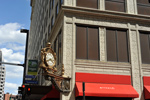
The clock outside the Macy's store has lasted longer than the name above the door of the Downtown fixture, which in 1885 became home to a store doing business as Kaufmann Brothers. Justin Merriman | Tribune-Review
Macy’s is putting its historic, 13-story Downtown store on the selling block, with plans to lease back part of the space.
The department store chain didn’t name an asking price for the landmark that fills a block on Smithfield Street, between Forbes and Fifth avenues. Macy’s retail operations fill 10 floors, and offices are on part of a separate floor.
Macy’s Inc. has been considering its options for the Downtown building — which was the flagship store of Kaufmann’s for most of its history — during the past year or two, spokesman Jim Sluzewski said Wednesday.
“Our initial goal is to sell the building, and then lease back the space we need for a store and offices,” he said. If that can’t be done, Macy’s could find tenants for unused or now-underused space in the building, he said.
Sluzewski said the amount of space Macy’s retains in the building will “depend on discussions with a potential buyer.”
Commercial real estate firm Cassidy Turley of St. Louis is marketing the store, which has 750,000 square feet of space, nearly 14 football fields.
Macy’s is jumping into the Downtown real estate market at a time when other major buildings also are for sale — Gateway Center, the Henry W. Oliver Building, EQT Tower, the Regional Enterprise Center and the Red Cross Building.
“The Downtown Pittsburgh market is extremely active now and is attracting a lot of interest,” said Pat Sentner, a principal with real estate firm NAI Pittsburgh Commercial.
The department store chain’s intent to lease part of the building makes it attractive to buyers, he said. But what’s important is how much space the retailer wants, and for how long, he said.
“If 75 percent or more of the building is part of the leaseback arrangement, that could attract an institutional type of investor” such as an investment group or foundation, Sentner said. If Macy’s wants half the space or less, a corporation or law firm might want to buy the building and use most of it for offices, he said.
Preserving the store in some form is key to keeping Downtown healthy and vibrant, observers said.
“It’s important to keep Macy’s Downtown and continue it as a retailer of excellent merchandise,” said Mike Edwards, president of the Pittsburgh Downtown Partnership. “I’ve seen it in other cities. Department store owners are retailers who don’t want to own real estate.”
Retail expert C. Britt Beemer said Macy’s closed stores in several downtown areas in recent years. “Pittsburgh is fortunate to have one, and it’s good to maintain downtown stores — they have a history and a sense of integrity.”
“Department stores used to be major property owners in many cities. Now they’re mainly tenants in malls and shopping centers,” said Beemer of America’s Research Group in Charleston, S.C.
Cincinnati-based Macy’s owns 469 of its 850 Macy’s and Bloomingdale’s stores. Spokesman Sluzewski said Macy’s always is looking to maximize its use of space in stores. The company maintains many downtown stores, he said, citing 15 other examples.
Patricia Edwards of Storehouse Partners LLC in Seattle said department store chains, especially in the rough economy of recent years, “are really trying to make sure each individual store is profitable, as opposed to just the chain itself.”
In September 2006, Macy’s kicked off its new presence Downtown and elsewhere in the region with a block party on Smithfield Street. It promised to keep the landmark corner clock at Smithfield and Fifth, the Tic Toc restaurant on the first floor, holiday events and other favorite Kaufmann’s features.
Still, Duquesne University marketing professor Audrey Guskey said shoppers in the region gave Macy’s a lukewarm reception.
“A lot of people were disappointed in the quality of merchandise, the service and the hours,” she said. “Also, Macy’s goal was to become a national department store, and they were very cookie-cutter — the Pittsburgh stores were like Cleveland, L.A. and Chicago.” Macy’s since then has been tailoring merchandise to various regions’ tastes, Guskey added.
In the past three decades, Downtown has lost four department stores, including a Lord and Taylor department store next to the Macy’s building.
Macy’s sales nationwide last year totaled $23.5 billion, down 5.6 percent from 2008. The company’s profit was $350 million, after a $4.8 billion loss in 2008.
____________________________________________________________________________________
Key dates:• 1877: Brothers Jacob and Isaac Kaufmann open a four-story store at Smithfield Street and what now is Forbes
Avenue, moving their tailoring business from the South Side.
• 1885: Store becomes Kaufmann Brothers, filling a block between Forbes and Fifth avenues.
• 1913: Another expansion brings the store to 12 stories.
• 1946: May Department Stores Inc. acquires Kaufmann’s.
• 1955: A 10-story addition on the store’s Fifth Avenue side is built, along with a parking garage.
• 2002: May closes Kaufmann’s headquarters on the Downtown store’s upper floors. About 1,200 jobs are lost.
• 2005: Macy’s parent, Federated Department Stores Inc., buys May company.
• 2006: Kaufmann’s and department stores in other cities that were part of May are changed to the Macy’s name.
-
Pittsburgh Offers Plenty of Refreshing Water Havens During the Summer Months: A Walking Tour of the City’s Fountains and Water Feaures
Sunday, July 11, 2010By Bill Toland, Virginia Linn, Patricia Lowry, Marylynne Pitz and Katy Buchanan, Pittsburgh Post-GazetteOur crown jewel fountain at Point State Park (No. 1 on the map above) is dry until 2012 while it undergoes repairs, and a few others also need work, but there are plenty of other burbling basins to enjoy in the city. Some are old, some are new, some tucked away and some in plain view. But they all make a splash, so put on your walking shoes, follow this guide and discover the cool fountains of Downtown Pittsburgh.
__________________________________________________________________________ 1. Point State Park
DETAILS: When it rose for the first time on July 23, 1974, the fountain in Point State Park sprayed a geyser of water that was 150 feet high.
At its formal dedication that August, the magnificent column of water signified the park’s completion, the importance of rivers to the region’s growth and the city’s first renaissance.
The fountain cost $1 million and the 6,000 gallons of water that circulate through it each minute come from Pittsburgh’s “fourth river,” which flows 54 feet underground. When running, 800,000 gallons of city water recirculate through it daily.
Designed by Ralph Griswold and Charles Stotz, the fountain has experienced its share of problems, including flooding that deposits mud, silt, logs and other debris.
Between 2007 and 2012, Point State Park and its fountain will have been renovated at a cost of $42 million.
“It’s the largest park project in commonwealth history,” said Edward Patton, director of capital projects for Riverlife, a public-private partnership whose mission is to improve the region’s riverfronts.
The fountain’s circular base is 200 feet in diameter. Plans call for cleaning its circular granite rim and adding a second, higher tier over which water will flow into the basin at the rim level. People standing on the great lawn will be able to see the overflow tier.
The plaza around the fountain will be raised 18 inches, making it easy for visitors to sit on the rim and access its water. The sandstone block plaza will be dug up, cleaned and relaid. For the present, the fountain is inaccessible during construction.
2. TrizecHahn Plaza (formerly Equitable Plaza)Bounded by Liberty Avenue, Stanwix Street and Boulevard of the Allies
COMPLETED: 1961
DETAILS: The plaza sandwiched by the former state office building on the west and Gateway Four and the Verizon Building on the east was designed by Simonds and Simonds, Pittsburgh’s renowned landscape architecture firm (now known as Environmental Planning and Design). It features shady pergolas, benches, planting beds and two rectangular, nearly flat fountain basins, one hidden at the back where the plaza segues into a walkway over the Boulevard of the Allies.
A partial redesign of the plaza in 2004 surrounded the fountains, frequently a magnet for kids on hot summer days, with mounds of grasses, roses and coneflowers. Post-Gazette architecture critic Patricia Lowry in 2009 wrote of the redesign: “Part of the geometric-patterned gray and white terrazzo, so striking from above, has given way to a winding path of square pavers that seems more pastoral than urban.”
3. Gateway CenterBounded by Liberty Avenue, Stanwix Street and Fort Duquesne Boulevard
COMPLETED: 1956
DETAILS: When it was dedicated in 1957, city officials baptized it with waters from the Ohio, the Monongahela and the Allegheny. It’s been obligingly accommodating the rumps of lunching workers, arts festival-goers, smokers and, more recently, texters and cell-phone talkers ever since. The fountain, with its bronze vase and turquoise basin, was designed by the prominent New York firm Clarke & Rapuano, which also consulted on Point State Park. At the time it was christened, Post-Gazette files show, it was called the Fountain of the Three Rivers (one of several by that name in the world) though that name does not find itself in general usage.
4. Wood-Allies Garage228 Blvd. of the Allies
COMPLETED: 1985
DETAILS: Completed as part of the public open space component of a city-owned parking garage, “Pittsburgh People” was a favorite project of its creator, Pittsburgh artist Jerry Caplan. Working with terra cotta slabs and sewer pipes, Mr. Caplan created wall reliefs and figures for this sweet little pocket park that connects the Boulevard of the Allies with First Avenue. A large column depicts bas-relief figures in elevators, some modeled after known Pittsburghers such as Mayor Richard Caliguiri and Mr. Caplan’s good friend, artist Donna Hollen-Bolmgren. The artist himself is there, too. Other figures are meant to represent a variety of Pittsburgh types — steelworker, crossing guard, businessman, mother and child. Alas, it did not fare well over the winter; its fountains are not working at present and will not be fixed this year. Part of the wall relief is in need of restoration, too, apparently stained by salt leaching from the clay. The parking authority isn’t sure when the city budget will allow repairs to the concrete foundations and pumps.
5. PPG PlazaBounded by Third and Fourth Avenues one block east of Stanwix Street
FOUNTAIN COMPLETED: 2003
DETAILS: One of the greatest gifts to the people of Pittsburgh has been Henry Hillman’s computer-choreographed fountain built in the middle of PPG Plaza.
It surrounds what former Post-Gazette columnist Peter Leo affectionally dubbed the “Tomb of the Unknown Bowler,” a 44-foot obelisk built in what used to be a rather stark, barren plaza.
But each spring, the plaza gushes to life with a fountain of 140 jets of water illuminated by 280 underground lights. Recirculated water pulses up to a height of 15 feet from the granite floor, delighting children and adults alike who frolic in its lovely coolness.
The fountain was created by WET Design of Universal City, Calif. Mr. Hillman’s gift also covered the cost of converting the space into a popular skating rink each winter, which opened in December 2001 and was designed by IKM Inc.
Mr. Hillman, whose company owns PPG Place, has never revealed the price of the gifts.
6. Heinz Hall PlazaSixth and Liberty avenues
COMPLETED: 1982
DETAILS: The site used to hold a Woolworth’s store; now it’s a summertime alfresco dining space next to Heinz Hall, and water plays a starring role in this production. Officially called the Garden Plaza, it opened on May 7, 1982, part of a larger addition to Heinz Hall that was completed at the same time. In the spring and summer, a waterfall tumbles two stories in the back corner of the plaza, while a fountain burbles in the courtyard.At least, that’s usually the case — but this year the waterfall is turned off and the plaza is closed for repairs. It’s scheduled to reopen for the Pittsburgh Symphony Orchestra’s Bella Notte concert Sept. 16.
The courtyard and waterfall were designed by MacLachlan, Cornelius and Filoni; the kinetic water fountain (four circular platforms spilling water onto each other, called “Quartet”) was designed by London sculptor Angela Conner. Together, they use 10,000 gallons of recirculated water, drawn — as is the case with the Point State Park fountain — from the city’s underground aquifer.
7. One Oxford CentreThird and Grant streets
COMPLETED: 1983
DETAILS: Since One Oxford Centre opened, a soothing three-tiered fountain has graced the southeast corner of a sunken plaza at the office and retail complex.
Its eight plumes of water rise at various heights, providing a pleasant backdrop for patrons relaxing at umbrella-covered tables at the center’s ground-level Easy Street restaurant and Au Bon Pain. The fountain contains between 4,000 and 4,500 gallons of water.
The $100 million One Oxford Centre, a 46-story complex of offices, shops, restaurants, parking and athletic club, kicked off a second renaissance of Downtown development in the 1980s.
It was developed by Oxford Development Co. and designed by St. Louis-based global architectural firm HOK (formerly Hellmuth, Obata, & Kassabaum).
8. Allegheny County Courthouse436 Grant St.
COMPLETED: 1977
DETAILS: Henry Hobson Richardson, architect of the Allegheny County Courthouse of 1888, had intended that the courtyard it encloses be entered by vehicles and drew it as a brick-paved plaza with a watering fountain for horses as centerpiece. No fountain was built, and the courtyard’s wagons and carriages in time evolved into cars on an asphalt parking lot.
In 1976, Katy Flaherty, wife of then-Allegheny County Commissioner Jim Flaherty, floated her idea for transforming it with planters, trees and a fountain. The county couldn’t come up with the money, but when the Sarah Scaife Foundation donated $64,000 to Pittsburgh History & Landmarks Foundation for materials, the county provided the workers in 1977. County architect Samuel Kiss and urban designer Carla McDonnell consulted with Landmarks’ architect Ellis Schmidlapp on the design. The result is a quiet, welcoming refuge for workers and visitors.
9. PNC Firstside CenterFirst Avenue and Grant Street
COMPLETED: 2000
DETAILS: The watercourse, built for an efficient sum of roughly $300,000, runs along the full length of the building’s First Avenue facade, starting as a subtle wall of water at Grant and following a trough lined with cobalt-blue tiles all the way down to B Street.
The water course also follows the grade of First Avenue and was designed to be reminiscent of a river and stream, and to echo the Monongahela River flowing behind the building, according to Frank Dawson, head of landscape architecture at Astorino, which designed the complex. The groups of small stones in the upper part of the course serve as another reminder of a splashing stream. The watercourse circulates 850 gallons per minute and, by serving as a barrier between the building and the street, also serves as a security feature.
10. U.S. Steel Fountain600 Grant St.
COMPLETED: 1972
DETAILS: Across Sixth Avenue from Mellon Green is the plaza fronting the U.S. Steel Tower, the outdoor foyer to what remains the tallest building in Pittsburgh. The building opened in the fall of 1970, and the fountain (according to the best records available) was commissioned the next year by U.S. Steel. It holds about 45,000 gallons of water, making it one of largest fountains in the city in terms of capacity.
Today, the fountain — dozens of small exterior jets, encircling the main basin and the larger, central sprays — is flanked by outdoor patio tables, and on nice days is a popular gathering spot for lunchtime diners in the Grant Street corridor.
It was designed by California’s J.S. Hamel Engineering and Harrison, Abramovitz & Abbe of New York City; the latter firm designed the steel tower itself, as well as the old Alcoa Building.
11. Mellon Green FountainSixth Avenue and Grant Street
COMPLETED: 2001
DETAILS: Comprising five black granite columns spilling water into a terraced granite basin, the fountain was designed by Marshall Tyler Rausch Landscape Architects LLC, a West View firm.
The fountain, at the center of Mellon Green, sits in a round of trees and green space, about 1.8 acres. Originally that area had been designated for new commercial development — a Ritz-Carlton hotel, or perhaps a Macy’s store — but that never happened, and the result is a cool, shady fountain-centered lawn at one of Downtown’s busiest intersections, at the front step of Mellon’s Client Service Center.
The fountain, and the rest of the park, were dedicated in July 2001. It received the AIA Design Pittsburgh Landscape Architecture Detail Award in 2002.
12. Mellon Square ParkSmithfield Street, Oliver Avenue, William Penn Way and Sixth Avenue
COMPLETED: 1955
DETAILS: In October of 1955, thousands of people attended the dedication of Mellon Square Park, which features a jewel box of a fountain designed by John Simonds. The highlight of its geometric design is a plane of water that is cantilevered at ankle height, creating the visual effect of the water appearing to hover over the plaza.
Multiple jets spray water in a constantly changing pattern of heights and volumes. Each day, 34,000 gallons of water spill from five large bronze bowls into four small bronze bowls. The fountain pool is lined in tiles done in refreshing pastel shades of aqua and mint green.
Mellon Square’s 55,610 square feet were purchased with money from the A. W. Mellon Educational and Charitable Trust and the Sarah Scaife and Richard King Mellon foundations. The donors intended the park to be “a quiet and unspoiled haven of beauty, rest and relaxation.”
A three-phase renovation of Mellon Square Park — one of the nation’s original “green roofs” — is currently under way by the Pittsburgh Parks Conservancy with cooperation from the city’s Department of Public Works. New roof and architectural technology will dramatically improve the square, said Susan Rademacher, parks curator.
The project will cost $7 million. An additional $4 million will be raised for a maintenance fund.
After some repairs, the main fountain will be turned on some time this month. The water that cascades along steps leading from the plaza to Smithfield Street should be restored in 2011.
13. BNY Mellon CenterFifth Avenue and Grant Street
COMPLETED: 1994
DETAILS: The cascading fountain on the Fifth Avenue side of BNY Mellon Center is part of a triangular entrance plaza made of rose granite. Designed by architects Burt Hill, the fountain is near the building’s 82-foot-high, four-story, glass-sheathed entrance lobby.
Formerly called One Mellon Bank Center, the steel-clad, taupe building is bounded by Grant Street, Fifth Avenue, Sixth Avenue and Ross Street. The fountain is made of flamed finished granite and recirculates 300 gallons of city water per minute.
The plaza and cascading fountain were designed to provide a clear view of nearby buildings that are stellar examples of architecture, including Henry Hobson Richardson’s Allegheny County Courthouse, Daniel H. Burnham’s Frick Building, Frederick J. Osterling’s Union Trust Building and Benno Janssen’s William Penn Hotel.
Also located on the plaza are six L-shaped, polished granite chairs arranged in a circle. Sculpted by artist Scott Burton, they were exhibited in the 1985 Carnegie International. Mellon Bank purchased them and Mr. Burton oversaw their installation.
14. Agnes R. Katz PlazaSeventh Street and Penn Avenue
COMPLETED: 1999
DETAILS: The fountain in Agnes R. Katz Plaza is an unconventional one, more monumental bronze sculpture than fountain. In most of its channels the two streams of water flow almost imperceptibly, spilling over and making their presence known only as they near the basin. The artist was French-born Louise Bourgeois of New York, who died in May at age 98 and whose work often explored female and male imagery. Viewed from above, the 25-foot-tall Katz Plaza fountain suggests lactating breasts. Thanks to heated water, the fountain flows year-round.
This was Ms. Bourgeois’ first fountain; a later one, “Father and Son” in Seattle’s Olympic Sculpture Park, is an effusive celebration of water, which she has given a poetic mission. Figures of a father and his young son reaching out to each other are separated by waters that rise up and alternately engulf them, a metaphor for a relationship that sometimes can be distant and a gentle reminder to heal or avert the gulf.
15. The Regional Enterprise Tower (formerly the Alcoa Building)425 Sixth Ave.
COMPLETED: 1953
DETAILS: The three-pool cascading fountain made of granite sits off the lobby of the tower, in an open air courtyard, with one latticed wall, that is visible but not accessible to the public. When the building was occupied by Alcoa the courtyard plantings were kept up to date, but building manager Ed McMahon says that aspect of upkeep has fallen off since the transfer to the Southwestern Pennsylvania Commission. Pedestrians can view the fountain from the lobby or from the “bird cage,” the name given to the separate lobby space decorated with “Birds in Flight,” a sculpture by Mary Callery. Joyce Saltzman, Alcoa manager of corporate communication, recalls that during a long period of Alcoa’s tenure in the building, the company’s Christmas manger display was set up in the fountain area, enlivening the display as the figures’ costumes flapped in the winter air. The building was designed by Harrison & Abramowitz Architects of New York and Mitchell and Ritchey of Pittsburgh, who also designed Mellon Square garage across the street.
16. Allegheny HYP Club619 William Penn Place
COMPLETED: 1930
DETAILS: Tucked inside a courtyard surrounded by three 19th-century former tenement buildings — the only such buildings remaining Downtown — is the Allegheny Harvard Yale Princeton club. The courtyard fountain and back wall are composed of stones from the old Yale Library and the Princeton science building, both torn down about the same time in the 1930s. The use of salvage material was unusual for the time. The fountain, part of an intimate and inviting space for receptions, is on from April to September.
17. David L. Lawrence Convention Center1000 Fort Duquesne Blvd.
COMPLETED: 2003
DETAILS: They call it a “water feature,” but that seems such an understatement for the $7 million twin cascading fountains that stretch along a sunken corridor from the Penn Avenue area to a landing near the Allegheny River.
As part of the $375 million convention center’s green design, renowned architect Rafael Vinoly created the fountains to help with the building’s energy efficiency. A water cooling system uses the fountains on both sides of the serpentine, stained concrete path as a heat exchange system. Walls of water flow into separate 12- to 15-inch-deep pools along the 400-foot corridor that runs between and below the lanes of the divided 10th Street.
The whole watercourse holds 400,000 gallons of recirculated water.
What Mr. Vinoly probably didn’t count on when the center opened in 2003 was how vulnerable the bypass is to flooding from the Allegheny River. On several occasions the water feature has been turned off so sediment can be cleaned up after the river has overflowed its banks.


